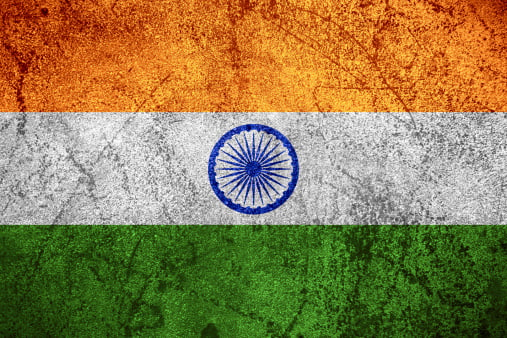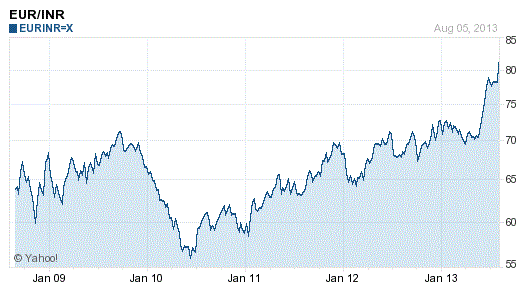Can Raghuram Rajan Save India from an Economic Meltdown?
August 6, 2013 by Jon C. Ogg
What we are curious about is whether Raghuram Rajan can save India’s economy, stock market and status as a great emerging market; keep the rupee from cratering further; and most importantly cap inflation in a manner that will still allow India’s GDP growth to pick up again. The rupee is now down about 13% against the U.S. dollar in just six months. India’s central bank is tightening up when it needs to be looking for ways to expand. Raising interest rates and capping daily bank system injections is not the best policy when your markets and economy are not growing at rate fast enough to support your population.
The BSE Sensex was down more than 2%, and the yield on the nation’s 10-year central bank bond is up at about 8.20%. Unfortunately for its population, India’s inflation is nearing 10%, and that is not acceptable by any measure. The five-year chart of the rupee against the dollar shows just how bad things have become, and the same is true against the euro as well.
Here is how key ETFs and funds that track India are doing:
WisdomTree India Earnings Fund (NYSEMKT: EPI) is down more than 2.5% in early Tuesday trading and hit a new 52-week low of $14.92, against a 52-week high of $20.50.
PowerShares India (NYSEMKT: PIN) is down 2% at $15.65, against a 52-week range of $15.53 to $19.66.
The India Fund Inc. (NYSE: IFN) is down 2.2% at $19.28, against a 52-week range of $18.06 to $24.10. CEFA.com shows that it trades at roughly a 12% discount to its net asset value.
Market Vectors India Small-Cap ETF (NYSEMKT: SCIF) is down 2.3% and hit a new 52-week low of $24.83. To show how bad this one is doing: its 52-week high is $46.60. When something is down almost 50%, is it fair to ask if it is on sale?
Market Vectors Indian Rupee/USD ETN (NYSEMKT: INR) and WisdomTree Indian Rupee (NYSEMKT: ICN) are both performing poorly as well in the currency exchange traded note (ETN) world, although their trading volume is too thin to monitor. Direxion Daily India Bull 3X Shares (NYSEMKT: INDL) also is cratering, with a loss of almost 7%, but we tend to ignore the triple-leverage exchange-traded products.
India’s 2012 gross domestic product (GDP) was $4.76 billion on a purchasing power parity basis, making it the fourth largest economy in the world. It also grew by 6.5% in 2012, but that is actually too slow to keep up with its population. India’s GDP per capita is ranked all the way down at number 168 in the world, according to the CIA World Factbook, because its GDP per capita was only $3,900 in 2012. As of 2010, almost 30% of the nation lived below the poverty line. India’s largest problem, outside of how to handle the infrastructure for a rapidly growing population, is that it has suffered from higher inflation that the rest of the world.
Raghuram Rajan is well respected, and he did foresee and warn of economic troubles back in 2005 and 2006. That being said, India has to hope he can work some magic. In fact, Raghuram Rajan may have to be a snake-charmer to save the day.
Sponsored: Attention Savvy Investors: Speak to 3 Financial Experts – FREE
Ever wanted an extra set of eyes on an investment you’re considering? Now you can speak with up to 3 financial experts in your area for FREE. By simply
clicking here you can begin to match with financial professionals who can help guide you through the financial decisions you’re making. And the best part? The first conversation with them is free.
Click here to match with up to 3 financial pros who would be excited to help you make financial decisions.

